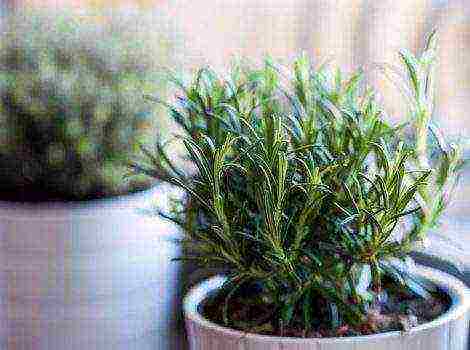Content
- 1 How to breed and raise geese at home for beginners?
- 2 How to care for, raise and keep goslings
- 3 Conditions of keeping and feeding
- 4 Geese rearing period
- 5 Goose eggs: how much can you eat and how are they useful?
- 6 Why geese are good
- 7 Which breed to choose
- 8 How to choose young animals
- 9 Requirements for the conditions of keeping goslings
- 10 Feeding goslings
- 11 What are the advantages of breeding geese
- 12 Nursing goslings
- 13 Care and rearing of geese
- 14 The difference in the diet of geese at different stages of rearing
- 15 Benefits
- 16 Birds as a business
- 17 Brief description of the most popular breeds
- 18 Necessary equipment
- 19 Breeding chicks
- 20 Feeding recommendations
- 21 Feeding during oviposition
- 22 Winter maintenance
- 23 Additional lighting
- 24 Summer maintenance
- 25 Poultry implementation
Geese occupy a special place among poultry. If chickens are bred mainly for the purpose of obtaining eggs, then geese are raised for the sake of tasty, juicy meat.
Although it is inferior in dietary characteristics to chicken due to its high fat content, it is still very useful. It contains trace elements and vitamins A, C, B, including B12, which is deficient for many, mineral components - iron, zinc, manganese. Goose meat is especially appreciated for its amino acid content, from which antibodies against viruses are produced in our body.
In this article, we will take a closer look at breeding, keeping and caring for geese at home for beginners. We will find out if it is possible to eat goose eggs, how they are useful and how much they can cost. After reading all the information, you will be able to raise healthy and strong birds.
How to breed and raise geese at home for beginners?
First, let's talk about breeding geese at home. The specificity of keeping geese is that they cannot be raised in cages, like chickens. This explains why their population is much smaller. It is advisable to breed this bird in the event that there is a place nearby for them to walk - a pasture with a reservoir (rivulet or lake). Geese need space. They have to walk and move a lot. Because of this, their meat is darker than chicken meat (there are more blood vessels in the muscles).
Breeds of geese for breeding
The most common breeds are as follows:
Large gray geese - weigh 6-7 kg. Egg production is 37-47 eggs. Eggs are large - 150-200 g. Very hardy.
Chinese geese - live weight reaches 5 kg. Egg production - 50-60 pieces per year with a weight of 130-170 g. They are hardy, but aggressive by nature.
Lindovskaya breed - the mass of adult geese is 7-8 kg. Egg production is 45-50 eggs with an average weight of 120-140 g.
The Kuban is a domestic breed. Egg production - 80-90 eggs per year. Average live weight -4.5-5.5 kg.
Kholmogory - weigh more than other breeds - 8-10 kg. But egg production is 30-40 eggs per year, but their weight is more than 200 g. They are calm and non-aggressive.
Italian geese - are characterized by high productivity of meat. Live weight - from 6 to 7 kg. Egg production - up to 50 eggs per year.
Toulouse - French breed. It is considered the largest with a weight of 10 kg or more. Egg production - 30-40 eggs per year with an egg weight of 190-210 g. They are calm and inactive, feed well and quickly.
Emden geese weigh 8-9 kg. Egg production is low.
Rhine - bred in Germany. In terms of their characteristics, they are similar to those of Emden.
 Breeding geese on the farm. Different breeds.
Breeding geese on the farm. Different breeds.
Hen eggs
It is better to hatch geese chicks from an egg with a brood hen, than in an incubator. However, if there is only one hen in the poultry farm, then a maximum of 13-14 heads are obtained for the brood, since the eggs are large. If you still choose this method of obtaining chicks, then first create the necessary conditions. Temperature indoor supported at the level of 14-15 degrees.
It should be dry and well ventilated, but free from drafts. The nest for the goose is made spacious. Be sure to separate it from the rest of the livestock and fence off the nests with partitions between themselves (in case there are several hens). Keep hens separate from the rest of the geese. This is due to the fact that geese can lay eggs in an already hatched clutch during the absence of the expectant mother. Thus, the period for obtaining goslings will stretch in time, which is very bad for their further development.
We monitor the dryness in the nest. An accidentally broken egg must be urgently removed and the rest of the survivors wiped up. The need to make partitions between nests is explained by the fact that in the absence of one hen, the other rolls several eggs to itself, since their maternal instinct is very developed.
An extra number of eggs in one nest will make it impossible to heat them all at once. In addition, there is an additional risk of damage to them.
We make sure that when the hens return to the nest after the necessary exercise, food intake and water procedures, they occupy their nests, and not confuse them with the neighbors. During incubation, we change the water in the drinking bowl of the future mother every day to avoid diarrhea and feed it only with selected grain. The hen will take care of all the hatching processes herself.
She herself rolls the eggs in the nest for even heating. If for some reason the goose does not return to the nest after eating for 20 minutes, it is driven onto the nest. This happens mainly with a bird sitting on eggs for the first time.
The first chicks appear on the 28th day. After that, they are taken from the nest, placed in a separate box, illuminated with a lamp, creating the desired temperature. After all the chicks are born, they are returned to the goose. In the first two days, mom can put several chicks from eggs hatched in the incubator. Do this in the evening.
Eggs in an incubator
Breeding chicks geese in an incubator harder than chickens... This is due to the fact that goose eggs contain a lot of fat and are large in themselves. If more than 70% of chicks hatched from one bookmark, then this is a good result. Several features of the incubation of goose eggs:
- take away them within 10 days - no more;
- preliminary 3-4 hours before bookmarking the incubator is warmed up with an elevated temperature of 39 degrees;
- take away only healthy perfect shape eggs;
- you can't wash them, but disinfection can be carried out by spraying with a light solution of potassium permanganate;
- the first 4-5 hours after setting the temperature in the incubator withstand at around 38 degrees... Then it is reduced to 37.8. The last couple of days it has been reduced to 37.5 degrees;
- eggs are turned 6-8 times a day to prevent the shells from sticking to the mesh or mold and for uniform heating;
- so that harmful gases do not accumulate, the incubator periodically after 15 days of laying open for 10 minutes to ventilate.
 Breeding geese. Goose farm
Breeding geese. Goose farm
How to care for, raise and keep goslings
It is extremely important to care for goslings at home from the first days of life.
With the beginning of life, the immune system of the body of goslings is formed and strengthened. therefore it is important to have a balanced dietto grow a large and healthy bird. For each period of growth and development, its own diet is compiled. Feeding the newly hatched goslings is also extremely important.
Care for goslings in the first days of life
When caring for goslings at home, for the first 5-7 days, it is useful for chicks to give the yolk of boiled eggs.It is well absorbed by the immature organism of goslings. When feeding, it is recommended to add greens. Better to eat this green onion feather. It is finely crumbled and mixed with the yolk. During the first two days, the hatched goslings are fed 7-8 times a day.... It depends on this whether you will be able to raise healthy geese.
Drinking bowls are chosen so as to protect the brood from the risk of drowning or drowning in it.
We make sure that the enclosure where they are kept is dry.
Care in the first weeks: how to raise healthy geese
Gradually, the diet is diversified with herbs and increases its presence in the feed. In addition to green onions, alfalfa and clover are given. We monitor the availability of clean water in the drinking bowls. Gradually, we introduce boiled potatoes and corn porridge into the diet.
Drinking bowls are replaced with more voluminousso that the goslings can swim in them. They turn into small bodies of water. To do this, use pots or bowls, but with low sides. This is a prerequisite.
The presence of the required amount of nutrients and vitamins in food will be provided by chopped root crops and vegetables. If we cook porridge for goslings, that they should not be too liquid. It is recommended to give more dry food.
We gradually transfer the three-week-old goslings to pasture. It is advisable that they graze in an outdoor enclosure. Together with the grass, they eat compound feed and crushed grain..
We introduce new feed into the diet in a small volume, gradually increasing its presence in the total feed mass.
Care in the first months
How to care for goslings at home? Starting from this period, goslings are intensively fed with compound feed, grain, sunflower cake and greens. They are grazed in an open small reservoir without a strong current. In addition to grass, they eat algae, which has a positive effect on the development and growth of body weight.
The proportion of greens to all other feeds should be 1-1.3: 1. That is, greens give more. In this case, the content of goslings will be cheaper and this will not affect the set of live weight.
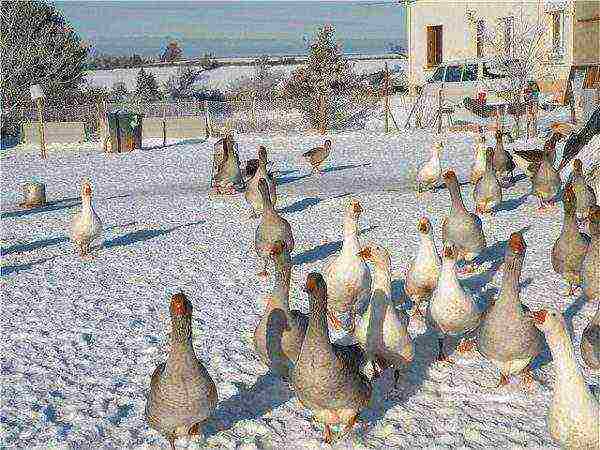 Winter hardiness of farmed geese
Winter hardiness of farmed geese
Conditions of keeping and feeding
In addition to food and water, goslings need an appropriate ambient temperature, sufficient room volume, and lighting.
Choosing an aviary for a goose farm
Depending on the number of livestock, we choose the appropriate room. In the early days, goslings are kept in cardboard boxes on the veranda, in the summer kitchen. Then they are given a place in the poultry house, shed. It must be well ventilated (ventilation) and warm, no drafts allowed. It is necessary to exclude the possibility of predatory animals entering there, primarily rats.
Straw and floor are used as bedding. We change the litter every 2-3 days to keep it dry. This will save the still immature chicks from diseases and hypothermia. The presence of a window into the room is a prerequisite. Geese love to be in a closed dark space only during sleep.
After three weeks of life, we construct a walk for the goslings in the open air, since during this period they are transferred to pasture.
After 40 days, they are grazed near water bodies. But until they have grown stronger, and are not able to defend themselves on their own, the presence of a person is mandatory. As soon as the live weight reaches an average of 2 kg (depending on the breed), geese are released on their own to graze.
It is better to do this in the early morning - the grass is then juicy and nutritious. Geese find food for themselves. They are perfectly oriented in space, so they can easily find their way home. Adult geese have their wings clipped to prevent them from flying away.
Daily temperature regime and lighting
In the first week of life, we maintain the temperature at 28-30 degrees. If the natural ambient temperature is not enough, heating with heating pads or lamps, which, in addition to light, give heat to the room. We measure the temperature at the level of the litter.
We gradually reduce it to 22-24 degrees. And after three weeks, if the weather permits, we transfer the goslings to the mode of life in natural conditions. In general, adult geese are quite hardy birds due to their presence of fat, large live weight and warm plumage.
They can freely withstand temperatures up to minus 15 degrees. There should be enough lighting to maintain normal conditions with extended daylight hours (more than 14 hours). For this purpose, lamps are used.
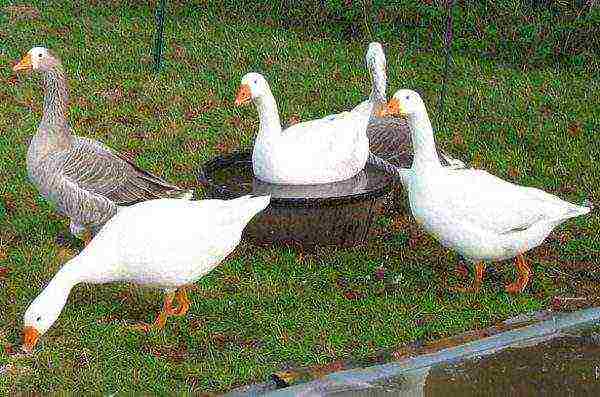 Conditions for breeding and keeping geese
Conditions for breeding and keeping geese
Room dimensions
The main condition for the size of the room for goslings is that it should not be crowded.
Cage content for goslings is absolutely unacceptable. They have to move.
Provide free access to food and water. When the young grow up, it is recommended to release them in the fresh air into specially fenced pens during the day. At night they are in the barn (goose-house).
Geese rearing period
Now we will find out how many geese grow. If day-old chicks weigh only 100 grams, then after 5 months their weight reaches 5-6 kg. On average, this bird gains more than one kilogram per month. In order for the geese to be healthy, and the live weight reached good weight indicators, you need to carefully and carefully monitor their diet.
The weight of adult geese of different breeds varies from 4.5 kg to 10 and more. If you plan to breed geese for meat, then it is advisable to keep them up to two to three months of age. During this period, they gain 50% of the mass of an adult one-year-old bird. Further, the weight gain is suspended.
Goose eggs: how much can you eat and how are they useful?
Depending on the breed, geese produce between 30 and 90 eggs per year. They differ in their size (up to two hundred and twenty grams) and thick shell. They can be used in food and it is healthy, but due to the fact that they contain a lot of fats, they need to be eaten in moderation. Our ancestors ate eggs of geese 7 thousand years ago. This is the first domesticated bird.
100 g of raw eggs contains 185 kcal, including proteins and fats - more than 13 g. They include vitamins K, D, E, A, B, micro- and macroelements. Their use has a positive effect on the brain and genitourinary system, the elimination of toxins. The goose egg is widely used in cooking and cosmetology.
Now you know that breeding and keeping geese at home is profitable. Indeed, in addition to the quick return of meat, geese provide us with eggs and down. For the successful rearing of geese, it is advisable to have a pasture and an open reservoir. In this case, with sufficient care and proper nutrition, their maintenance will pay off many times over. Perhaps even in the future, goose breeding will become your main source of income.
Along with chickens, which are born not only by rural residents, but also by ordinary summer residents, geese are also very popular as poultry. These birds easily adapt to various conditions of detention, are resistant to diseases and at the same time are very smart, and, most importantly, are quite unpretentious. Even beginners can cope with raising geese at home. At the same time, keeping geese is very beneficial and is an excellent help for the family budget.
Growing geese at home
Why geese are good
No matter how trite it may sound, a goose is a useful bird. This is one of the first feathered creatures that humans have tamed. Since that time, geese serve people regularly. Legends, myths, interesting tales and exciting stories are associated with these birds. The most famous is how the geese saved Rome, clucking in time and thus warning the Roman soldiers about the invasion of the enemy.
Geese are unpretentious birds in keeping. If you provide them with a roof over their heads in the form of a barn, and on a sunny day you take them out to the pasture and give them the opportunity to swim in a pond, then they will repay you a hundredfold. As a result, you will receive:
- meat with excellent taste;
- goose liver, which is very useful and highly valued;
- nutritious and tasty eggs;
- soft fluff, which is useful in everyday life.
By the way, earlier people used goose feathers in everyday life - they were used as a means for writing. Geese feathers can now be used to create crafts and decorations.
The photo shows goose down, which can be realized or used in everyday life.
Which breed to choose
Thanks to the work of breeders of geese breeds, there are nowadays quite a lot - about 25. Birds differ in appearance, size, maintenance requirements, growing conditions, egg production and other characteristics. And newcomers to the poultry world often wonder which breed to choose.
Choosing a goose breed is one of the most important tasks.
Goose breeds are divided into three main categories:
- Heavy, in other words, meat breeds. Geese of these breeds give more meat than others, and it is advisable to grow them for food. Representatives of this category are large, rarely used in industrial poultry farming, since some breeds of birds are difficult to acquire, moreover, they are far from cheap. Heavy geese are distinguished by low egg production compared to representatives of other categories, which means they are difficult to breed.
- Medium heavy the breeds are mostly decorative and are designed to give a personal plot of a kind of rural charm. Such birds are quite expensive.
- Lungs - small birds that lay eggs well, and therefore are easy to breed. Widespread in industrial poultry farming. They eat a lot, but the masses do not gorge themselves.
The table below shows the main breeds of geese, which are most often grown at home.
Table 1. The main breeds of geese for growing at home
| Linda breed or linda | Refers to heavy breeds of geese, originally from the Nizhny Novgorod region. Beautiful large birds with white plumage. They are used in industrial poultry farming, as they have good egg production for heavy geese. Geese with good character, friendly, unpretentious care. They are bred for meat. Due to the white color of the feather, carcasses are very clean and beautiful, with a wonderful presentation. The average weight of an adult goose is from 8 to 12 kg. Geese sit well on eggs, do not leave their nests. Goslings grow quickly - at 3 months, the goslings already weigh about 4 kilograms. |
| Large gray
Large gray |
The name speaks for itself - the geese of this breed are massive, and the color of the plumage is gray on the back and white on the belly. The birthplace of the breed is Ukraine. The weight of an adult bird is from 6.5 to 9.5 kg. Egg production and clutch vitality are lower than those of the Lindovskaya breed. Goslings are actively growing and gaining weight quickly: at 2.5 months, a young bird reaches a body weight of 4.5 kg. An excellent breed for obtaining meat and liver. They are unpretentious in care: they do not even need a reservoir for normal well-being. There are no problems with feeding these birds either. |
| Rhine
Rhine |
A breed of geese belonging to the category "medium-heavy". Country of origin - Germany. Birds with white plumage, with good meat qualities, excellent egg production for this category. An adult goose weighs 5.5 kg, a gander 6.5 kg. Goslings quickly gain weight: at 2 months, feathered babies are already gaining 4 kg of weight. The breed is used for meat production and is also fattened for fatty liver. Geese do not sit on eggs very well, therefore it is not recommended for beginners to breed this breed on their own. |
| Tape breed geese
Tape breed geese |
An ornamental breed of geese that was developed in Europe. The plumage is white or gray-white. A characteristic feature of the appearance is long curly feathers on the wings, tail, back. Ribbon geese are small: the mass of adult birds ranges from 4.5 to 5.5 kg. Productive qualities are low.Geese of this breed are used to decorate the infield. |
| Kuban breed of geese
Kuban breed of geese |
Refers to light geese. The name speaks for itself about the birthplace of the breed - these geese were bred in the Krasnodar Territory. The color of the feathers is gray, sometimes with a brownish tint. The birds of this breed have a characteristic brown stripe on the back - the so-called "belt". The weight of an adult bird is about 4.5-6 kg. Egg production is quite high, but the instinct of brooding in geese is bad. The bird is unpretentious and adapts well to any conditions of keeping. |
| Italian breed of geese
Italian breed of geese |
White birds are native to Italy. They appeared in Russia relatively recently, about 30-40 years ago. The bird is unpretentious to the conditions of detention (it does not care about the presence of a reservoir), the young quickly gain weight - at 2 months, the goslings already weigh 4 kg. The instinct of incubation in geese is well developed. The birds produce meat with excellent taste, and the small size of the carcass makes it possible to use the bird for smoking. Also grown for fatty goose liver. |
How to choose young animals
So, having studied all the information about the most common breeds of geese, you made your choice in favor of the one that you plan to purchase and settle in your summer cottage. Now is the time to buy the young you will be raising. But here everything is not so simple: often unscrupulous sellers, trying to cash in, sell outbred goslings, and often even sick ones. Therefore, you need to approach the purchase of young animals with special care.
Choosing young goose
It is best to go to buy goslings in a company with a person who is familiar with this bird firsthand: he will help you choose high-quality and healthy babies, from which you will successfully grow a good bird. If there is no such person “at hand”, then follow these guidelines:
- Study the information about the breed you want to get.
- Exclude bird markets from the places where young animals are searched: here you will not get any guarantee that the goslings are thoroughbred and healthy. If the kids die on your site through the fault of the breeder's dishonesty, then no one will compensate you for material and moral damages. Better to go to a poultry farm.
- Choose those goslings that are already 5-7 days old. Too small birds can hardly tolerate transportation, and older birds can be shy and difficult to cope with.
- Evaluate the appearance of the birds: the fluff on the chicks should be yellow, soft and fluffy, and, most importantly, dry, without pieces of shell.
- The umbilical cord should be overgrown, without traces of crusts, and the down under the tail should be dry and clean, there should be no traces of any secretions on it.
- Examine the tummy - it should not be saggy.
- Look at the beak - there should be no discharge from the nostrils.
- Choose the most active birds: sedentary goslings sitting quietly in a corner with closed eyes can be sick. Small healthy chicks actively react to unfamiliar sounds and objects.
- Birds should stand firmly enough on their paws.
- When buying goslings, check if they have all the necessary vaccinations by age.
Requirements for the conditions of keeping goslings
And here you are - the happy owner of three, five, and maybe ten little yellow goslings. They huddled in a box and look at you with their beady eyes, asking: "Where are you taking us?" Of course, before you go to buy goslings, you had to equip them with a house in which they will live.
Geese should be kept in comfortable conditions, preferably with a reservoir on the territory
It is best to settle the kids in a specially built gosper. If this is not available, then a small shed will do. Before the young animals move into it, the barn is cleaned, disinfected, it is advisable to whitewash the walls, and cover the floor with straw with a layer of 10-15 cm.If it is still cold outside, and you have already bought the goslings, then settle them in the summer kitchen, where there is a possibility of warming up the room. By the way, goslings are kept in warm rooms until they reach the age of 15-20 days (warm weather should also be established outside by this time).
Young goslings should be kept in comfortable temperature conditions.
Temperature conditions are very important: if the birds are cold, they will clump together and crush each other, and they can also die from excessive heat. In order for the goslings to be comfortable, poultry farmers recommend observing the following temperature regime:
Table 2. Recommended temperature regime for young goslings
| 1-5 days | 28-27 degrees |
| 6-15 days | 26-24 degrees |
| 16-20 days | 23-18 degrees |
There should be drinkers and feeders in the baby room. To avoid dampness, place the drinkers on the grates, under which there is a tray-like container to collect the splashed water.
Small goslings cannot be kept in a crowd - they can overwhelm each other if there are too many of them: divide the room into separate compartments. On 1 square meter, about 10 goslings can easily exist at the age of 3 weeks. Moreover, in hot weather, the number of goslings in the same area should be reduced by 1.5 times.
It is important to keep the room where the goslings live, to update the litter.
Video - growing geese at home
It is possible to let goslings outside for a while from the first days of life, if the air temperature outside the window is high enough. Birds are taught to walk gradually. It is best to walk them in an open-air cage so that birds of prey do not get to them. Once the warm weather has finally settled, take the goslings to pasture where they can nibble on the grass. From 45 days with goslings, you can also visit water bodies.
Feeding goslings
Very young goslings are fed millet or oatmeal with the addition of finely chopped boiled eggs or cottage cheese. After 3-4 days, chopped grass is added to the food. At the age of 1 month, goslings include carrots in their diet - a source of carotene. It should be rubbed on a fine grater and given 5 times a day. A mixture of porridge, carrots, herbs and cottage cheese is called "mash", the goslings love it very much. It is given to babies 5-6 times a day. The mash should be crumbly, soft, but not watery.
Feeding little goslings
Experts advise buying goslings in the spring and summer, when nature dresses in its green outfit: during this period, there are plenty of natural pastures all around, where the goslings can graze and eat fresh green plants. By the way, a month-old gosling eats almost a kilogram of grass a day. Most of all, babies like nettle, dandelion, sorrel, sow thistle.
- In addition to food and fresh water, goslings also need to put a bowl of gravel or coarse sand - they are necessary so that the stomach of the birds can grind the food.
- Do not forget about water - geese drink a lot, and they should have water at all times. According to observations, one goose at the age of 50 days drinks up to 1 liter of water per day.
Geese must be provided with clean drinking water
- The peculiarity of geese is that they cannot distinguish the temperature of the food, so make sure that the food for the goslings is not hot or very cold.
- If you are raising goslings for meat, then it is advisable to feed them with highly concentrated feed mixtures, while about 50% of the total food should be fresh herbs.
You can slaughter goslings to get meat already at the age of 70 days - by this time they are already gaining a fairly large mass. If you missed the time, and the goslings have outgrown this age, then you need to start slaughtering in 60-70 days, when the growth of new feathers ends.
Video - tips for keeping geese

Foreword
Recently, many who have a personal plot are thinking about the establishment of poultry for fattening.In this case, raising geese at home is the most profitable and effective activity that even those who do not have much experience can cope with.
What are the advantages of breeding geese
Geese differ from other backyard birds by their unpretentiousness, excellent adaptation to our weather conditions and, practically, omnivorous. Only small goslings require special attention, and even then only those that are raised without the supervision of a mother goose. Adults in the herd may well stand up for themselves in front of possible predators (cats, dogs, foxes, hawks, etc.), they feel great both in the pen and in the pasture, have an excellent appetite and are content with any food that is offered ...
In addition to being easy to care for, geese make a lot of money. This is both excellent meat, which in terms of taste compares favorably with already bored chicken, and a large amount of animal fat. From them we get a delicious product - goose liver, the basis of the famous French foie gras dish. And goose down and feathers are several times superior in quality and durability to chicken ones.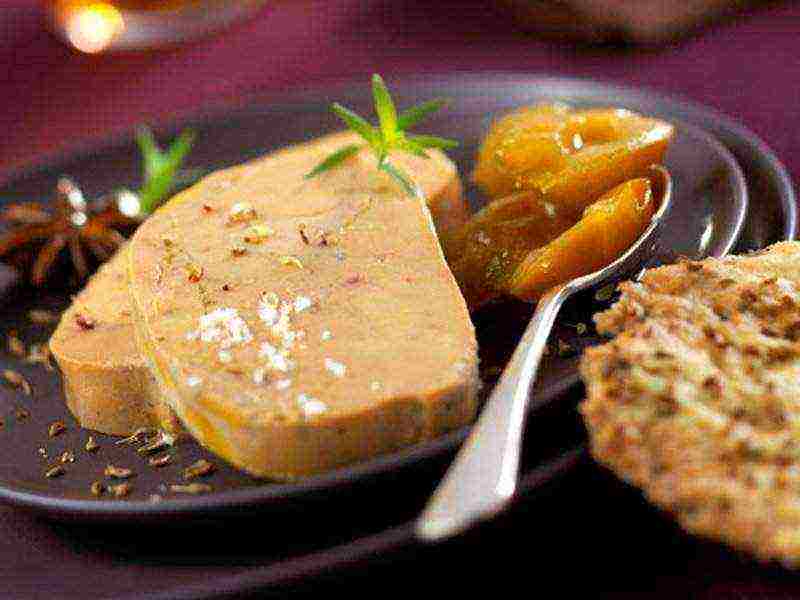
It is especially beneficial to keep geese if there is a lake, pond or just tinned fields near your site. This possibility of free grazing greatly facilitates the care of livestock and saves the cost of purchasing feed.
Nursing goslings
Like all chicks, little goslings require attentive, delicate attitude and almost round-the-clock care. But by adhering to certain rules of content and showing patience, you can achieve maximum results. Indeed, unlike tiny chickens and fragile turkey poults, baby geese are quite strong and hardy. That is why they are considered the optimal pets for beginner home farmers.
- Conditions of detention
To accommodate goslings, the warmest and lightest place in the poultry house is allocated. At first, it might just be a fenced-in corner or a cage. The area is allocated at the rate of 8-10 goslings per square meter. Dense population leads to frequent contamination of litters and difficult access to food, and in a larger area it is more difficult to ensure optimal temperature and microclimate
In the remote part of the corral, it is recommended to arrange a secluded corner, a kind of nest where the goslings will rest (for this purpose, a large cardboard box turned over on its side, covered with soft hay, is suitable). Feeders and drinkers are placed in the opposite direction to reduce contamination and wetting of the litter, as goslings not only drink water, but also often splash it. Drinking bowls need to be selected from which the goslings will not get wet, because even though in the future they are waterfowl, soaking the baby's light fluff can lead to colds and even death. The easiest way is to take a shallow container (a plastic can of preserves, a saucer or a small tray) and a half-liter jar. To set up an auto-drinker, a jar of water is dug up with a saucer, turned over and three or four sticks are placed under the neck, so that there is a gap for water to enter.
When it comes to bedding, dry sawdust is best for goslings under 10 days of age, as weak and clumsy chicks will get tangled in the straw.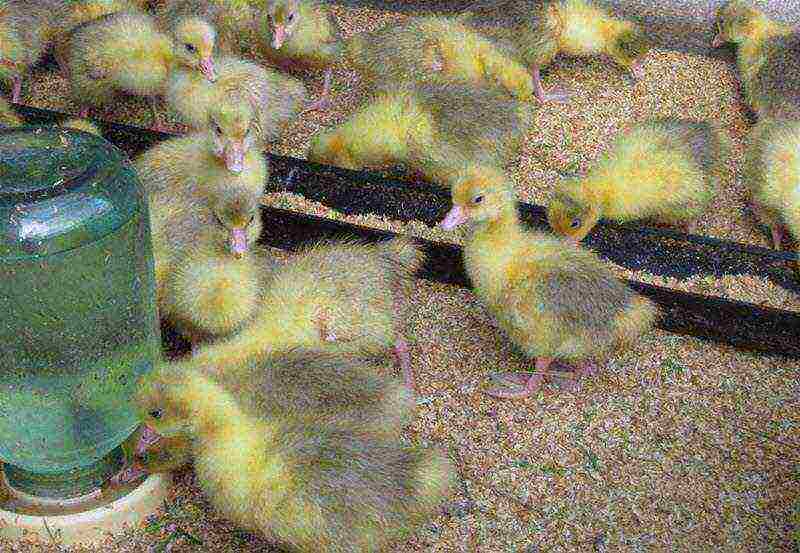
- Temperature and light conditions
At first, caring for geese is about ensuring optimal temperature conditions. Goslings hatched in the nest are surrounded by soft warm goose down, which will keep their chicks warm until they get stronger. When raising babies without a hen, you need to try to create conditions as close as possible to natural ones and maintain the air temperature in the pen at the level of 27-29 degrees, especially for the "resting corner" of goslings. There is often not enough heat from heated poultry houses or other ancillary rooms where goslings live.The most convenient and affordable way to keep young chicks warm is by using a red lamp. Such a heater will simultaneously solve the problem of illumination, which is important for goslings up to 10 days of age.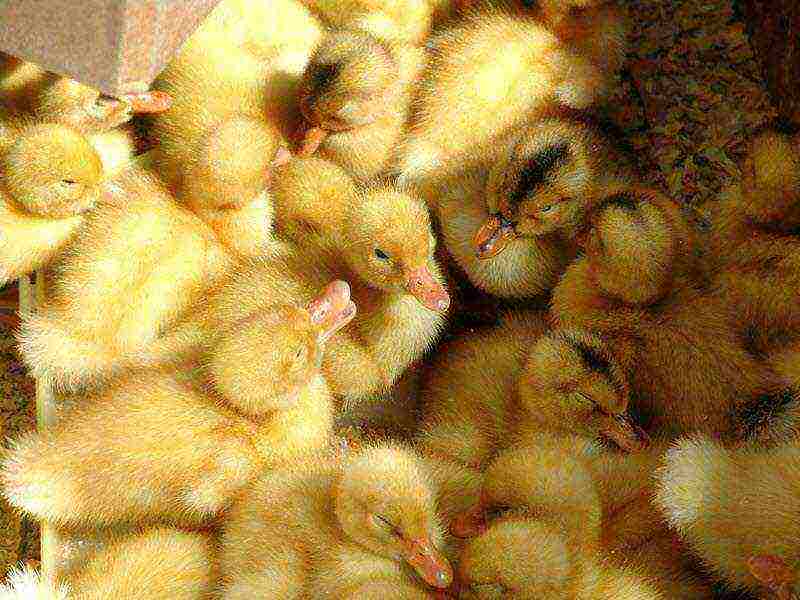
Over time, artificial maintenance of daylight hours is gradually reduced and brought to 17 hours a day.
- Feed and water
Feed for goslings is not much different from feed for chickens, therefore, it is most convenient to use ready-made feed, with optimally balanced ingredients, essential nutrients, vitamins and microelements. The diet of little goslings includes boiled eggs, low-fat cottage cheese and bone meal. From 10 days of age, it is useful for goslings to add chopped greens of yarrow, young nettle, dandelion, and green onions to the feed.
Advice! Small goslings should be crumbly. Too wet or viscous mass clogging the airways of the bird.
In the future, the goslings are equipped with a permanently filled, separate feeder with solid food: millet, crushed grains of corn, wheat and other cereals, so that the little ones have the opportunity to "refresh themselves" at any time.
But the question of providing goslings with drinking water should not even arise. Water is always needed, and in sufficient quantity. Growing up, the goslings will not only quench their thirst, but also try to bathe in the drinking bowl, splashing water and imitating swimming. And if chickens and turkey poults do not have a desire to get into the water, then for goslings this is a natural instinct. Because of this, accidents happen with babies - having climbed into the water and got very wet, they can no longer get out and die. Therefore, in a bowl of water, be sure to make a kind of island by placing a stone in the center.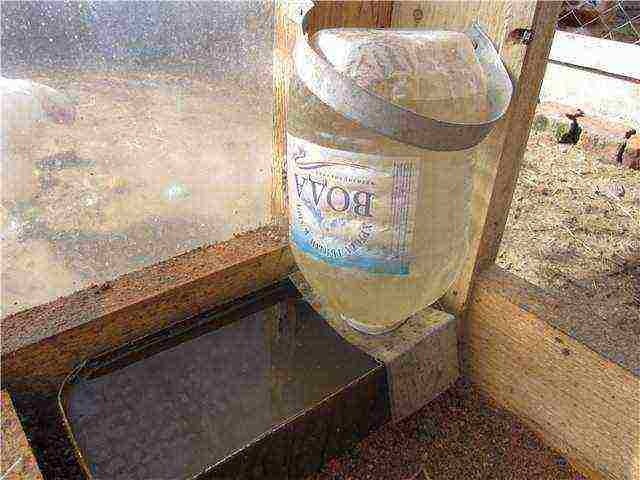
If you managed to hatch goslings up to the age of 10-15 days, then in the future the probability of losing the livestock is significantly reduced. Growing young and maturing individuals do not need such painstaking care, they are easier to adapt to temperature extremes, changing feeds and living conditions.
Care and rearing of geese
With the establishment of good weather, the goslings are transferred to fresh air. The sun strengthens their growing organisms, and fresh greens, bugs and worms diversify their diet. Geese, unlike other poultry, having the opportunity to nibble fresh grass on their own, may not even approach the feeders. Therefore, the prepared bags are given to geese in doses, from 3 to 5 times a day, depending on the availability of other food.
Speaking about the omnivorous nature of geese, it is worth noting some seasonal and age differences in their diet.
In the summer, when there is an opportunity to graze, the geese will spend whole days in the pasture, moving from one succulent grass to another. In this case, they are additionally fed only in the morning, before the pasture and in the evening, when the herd returns to the yard.
If your geese spend all their time in the courtyard, then the grass is "delivered" to them directly to the feeders. They gladly eat almost all juicy herbs.
An adult goose, being on free grazing, can eat up to 2 kg of green grass. Therefore, not being able to regularly graze geese, you have to compensate for the missing part of fresh greens with other food.
Vegetables are considered a good help in feeding geese. Growing cabbage, lettuce, spinach and other crops on your plot, you will always have a supply of feed. Overgrown cucumbers and zucchini, young roots of torn carrots, overripe radishes, green leaves of corn, grated fodder or sugar beets, as well as pumpkins and any melons will become juicy and vitamin food for your geese. During the apple season, cut fruit, especially soft varieties, will also be fed.
Advice! If the geese do not eat crushed apples too appetizing, try adding them to wet bags or "seasoning" with dry compound feed.
But what should not be fed to geese, and other domestic animals, is any kind of beetroot.This root vegetable provokes intestinal disorders and, as a result, a "relaxing" effect.
Do not forget about trace elements - there should always be a container with pieces of chalk and river shells in the pen. They not only enrich the goose's body with the necessary substances, but also help to digest food, which contains a large amount of fiber.
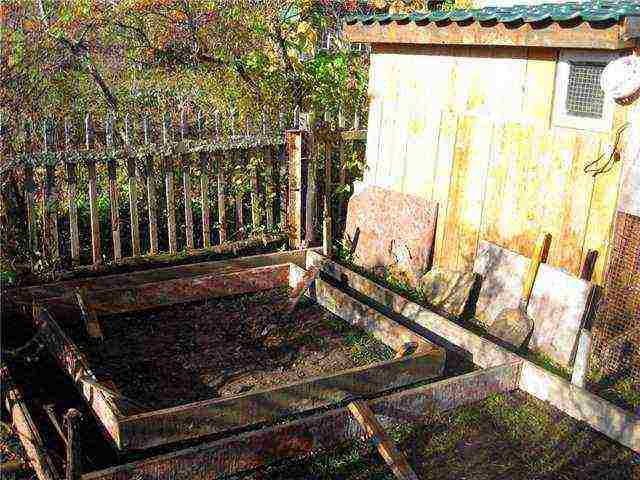
Everyone knows that geese love to splash in the water and swim. That is why many novice farmers are thinking about how to raise geese without having near a reservoir. The fact is that such a need is somewhat far-fetched. Geese can be successfully kept in their own backyard, without pastures and lakes. It is enough to install a container in the poultry yard and add water as needed. For this purpose, old troughs, bathtubs or even large basins are often used. Birds will gladly splash in such a compact artificial "pond", and the most energetic individuals climb inside and take water procedures to the envy of their relatives.
The difference in the diet of geese at different stages of rearing
Throughout the summer season, your geese have been eating mostly fresh plant foods. But closer to autumn, when it's time to gain weight and accumulate fat, it is worth revising the diet of birds. Home breeding of geese for meat involves intensive fattening of the livestock, starting in September. Now geese are less likely to be allowed to walk and graze, especially since there is almost no greenery left in the fields. They try to reduce the activity of birds by leaving them in the pen and providing constant food. Now the main element of the feed is nutritious cereal grains and high-calorie wet bags. For the preparation of mash, steamed compound feed is used, to which small boiled potatoes, grated fodder beets and more are added.
When the herd is already adult and the geese are in your sight all day long, you can notice the leadership positions of the gander and the most docile nature of some geese. It's time to choose parents for future offspring. Not sure how to choose a gander for a tribe? Pay attention to the largest, with a large weight gain and characteristic pedigree characters. The gander must be an "authoritative" leader, able to protect his flock. To obtain healthy, strong offspring, a pair should be selected from another brood to avoid incest. If you decide to leave your own geese for the future herd, then in the spring, for the services of a breeding gander, you can contact a neighboring farm.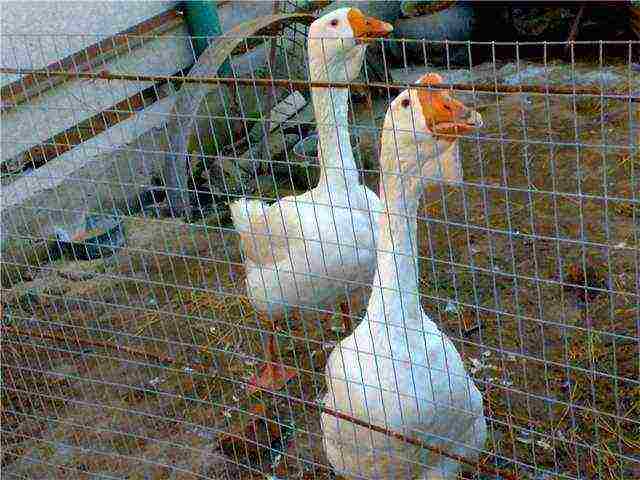
As you can see, feeding geese does not involve any particular difficulties. And if you want to start raising birds in your own backyard, then we recommend starting with geese.
Now many are engaged in raising poultry in their personal plots. Breeding geese at home is not only an aid in preparing meat for your family, but also an excellent profitable business, as it requires relatively low costs. From the first warm spring days, the geese can be passed to pasture. In addition, they are also beneficial because they are not afraid of cold weather, and already grown individuals can be kept in the poultry house on an irreplaceable bedding, but with the obligatory daily walking.
If you decide to start feeding birds, then, perhaps, the best option for you will still be geese. Breeding, keeping, caring for them is briefly described in this article.
Benefits
Domestic breeding of geese in the backyard is the second most popular after chickens. These large birds are characterized by their high early maturity. Goslings grow very quickly, and an example of this is the following fact: from one day of age to 9 weeks of age, they can increase their live weight by about 40 times. The weight of such a grown bird can be 4 kg or more. As you know, goose meat is famous for its high taste, and the carcass itself consists of 60-65% of edible parts.
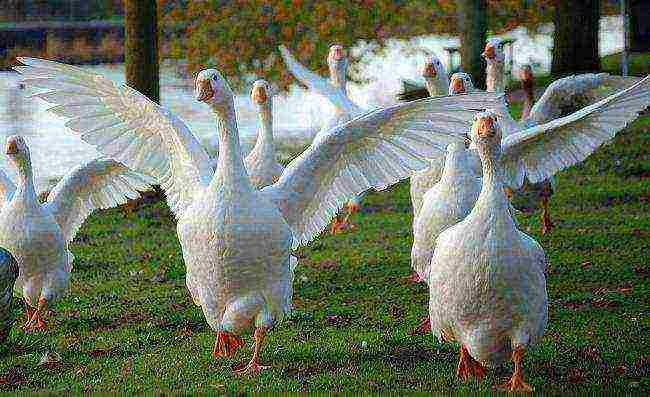
Birds as a business
Like any other business, breeding geese at home will require a certain amount for the initial investment. The purchase price usually depends not only on the number of heads, but also on their breed. Therefore, it is worth taking this issue more seriously.
The most popular breeds of geese for breeding are Italian, Toulouse, Kholmogory, Kuban, as well as Legart and Gray. Birds gain weight rather quickly and are the most resistant to various diseases. In addition, they have an enlarged liver, which is why they are appreciated and grown not only in personal plots, but also in industrial conditions. If the emphasis is on high egg production, then the breed of Japanese geese is just perfect. One such female can lay about 50 eggs per year.
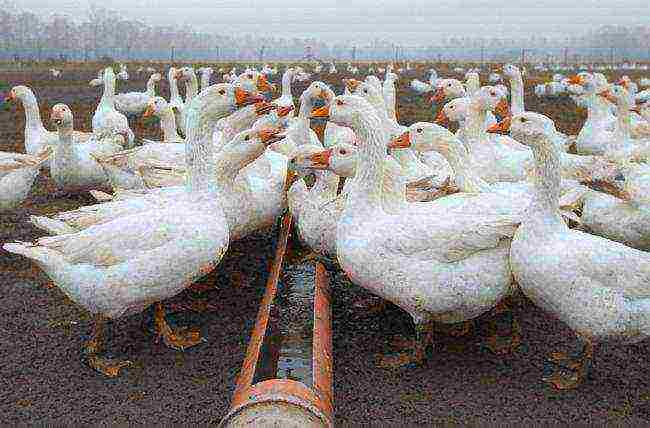
Making geese breeding your business is a good option for people living in rural areas. To start this type of activity, a small start-up capital is enough. It is not necessary to buy many heads at once, a hundred birds will be enough. For them, you will need to purchase food, as well as build a room. If there is already a barn, then the initial costs for this business are immediately reduced several times. It is also necessary to buy an incubator, which will cost about 10 thousand rubles. When adding up all the costs, taking into account the construction of the premises "from scratch", you can keep within the amount equal to 120 thousand rubles. And in order to sell finished products, you will need to register with the tax office.
Such costs will need to be done in the first year of work, and in the next year you can start breeding your own chicks. Often, farmers start breeding their own breeds, crossing several varieties of geese. As a rule, such activity improves not only egg production, but also the quality of the meat itself.
In order not to buy goslings, but to get them from your own birds, you need to collect eggs in advance and make nests for hens or lay them in an incubator for a certain time.
Brief description of the most popular breeds
● Italian. Ideal for growing in households. Gains body weight very quickly. Egg production per year is up to 45-50 eggs.
● Toulouse. This breed of geese is the fattest. It was bred in France and is valued for its large liver, which can weigh up to 1 kg. The weight of the goose is about 10 kg, and the gander is 2 kg more.
● Kholmogorskaya. Quite a large bird weighing up to 10 kg. Its distinctive features are folds under the beak and on the neck, as well as a bump on the forehead. The goose of this breed is capable of laying up to 40 eggs per year.

● Kuban. It is considered a light variety, since the bird weighs only 4.5 to 5.5 kg. However, it has a high egg production - about 70-90 eggs can be obtained from one goose.
● Legart. These geese, the breeding and keeping of which are believed to provide the greatest rearing benefit, consume 20% less feed than other breeds. However, they quickly gain weight. So, goslings who are 2 months old weigh up to 6 kg.
● Gray. Possesses good stamina and a fairly strong physique. Reaches a weight of 8 kg. The egg production of females is about 40 eggs per year.
Necessary equipment
Breeding geese at home will require the purchase of special equipment that will be needed to breed chicks.
● Incubator. This is the most important device you need to create the best possible conditions for your eggs.
● Ovoscope. A small device for detecting damage to eggs. Shining through them, he finds even small cracks in the shell. With the help of this device, breeding eggs are selected for subsequent hatching of chicks from them.
● Brooder. The hatched goslings are kept here. The device heats the young in the first days of life.
Breeding chicks
Breeding geese at home is done in two ways.The first one is incubator. Most farmers prefer to use this particular device for obtaining young animals. It allows you to make a large brood of chicks at a time. The first 14 days of life, goslings are fed with cottage cheese mixed with herbs and finely crumbled eggs. Later, mixed feeds are added to their diet. After reaching 3 weeks of age, chicks are fed in the same way as adult birds.

The second way is to breed the young by the goose itself. One brood hen can produce up to 13 chicks. The withdrawal period lasts about 28 days. Since geese are rather wayward birds, it is not recommended to disturb a hen sitting on eggs - at any time she may refuse to hatch them. A quiet, clean, dry and slightly dark place is good for the nest.
Feeding recommendations
In the diet of geese, in addition to plant and grain feed, sometimes even meat ingredients can be present. But there are some limitations to keep in mind. For example, in order to avoid a decrease in the egg production of geese, you should not give them barley and corn in their pure form. Otherwise, the bird quickly grows fat and does not rush well. Also, egg production can be significantly reduced due to feeding with meat waste.

Fattening geese at home is somewhat different in summer and winter. In the warm season, the diet of birds should include green mixtures of juicy herbs, as well as various vegetables: beets, carrots, legumes, boiled potatoes. When cold weather sets in, it is better to give preference to mixtures with tuber-root crops, various compound feeds and oats.
Feeding during oviposition
To obtain a high-quality hatching egg, it is necessary that the bird's body be provided with all the necessary set of minerals, because somewhere in February-March, the geese begins a period of breeding egg-laying. Therefore, special attention should be paid to their correct feeding at this particular time. To do this, the breeding bird is transferred to a more intensive feeding a month before the designated period. It should be noted that the goose will not be able to lay many eggs if it is weakened and exhausted. For good nutrition, hay, premixes and raw chopped potatoes are added to the feed. In addition, if possible, it is good to use also high-quality compound feeds containing in their composition a whole set of useful trace elements and minerals necessary for the bird's body.
Winter maintenance
At this time of the year, in the absence of grazing for geese, special rooms are built. There is no need to heat them, but the building must be of high quality. Wintering geese at home requires that the house be well insulated and completely free of drafts. To do this, equip a vestibule. In addition, the entrance doors are additionally insulated with cotton wool. Planks are usually placed on the floor, but earthen decking will work as well. The main thing is that it rises above the ground level by about 25-30 cm.
Caring for geese, although quite simple, requires special attention in some cases. If the bird is kept in a relatively small room, then in no case should the litter be allowed to be dirty or damp. Not only will this ruin valuable down and feathers, but it can also lead to serious colds. If the litter is dry, then the geese will be able to survive even the most severe frosts. As it can be used as sawdust and large shavings, and ordinary straw.
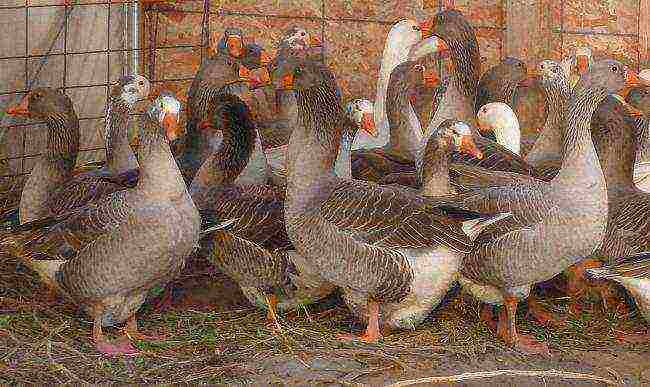
To keep the eggs clean and not trampled by birds, they should be placed along the walls of the board. Fresh bedding is placed on top of them. With this equipment in the house, the geese will get used to rushing in the same place. As for the litter, it is better to change it in the evening so that you can collect clean eggs in the morning.
Caring for a bird also involves combating skin parasites. For prophylaxis, in the room where the geese are located, a trough filled with a mixture of sand and ash is placed every 2 or 3 weeks.They bathe in it and thereby not only get rid of various parasites, but also clean their feathers.
Additional lighting
In order for geese breeding at home to be as productive as possible, it is necessary to take care of artificially increasing daylight hours. This will have a very beneficial effect on the egg production of geese. For example, if you turn on the lights in the house at 6:00 every day and turn them off at 20:00, then the birds will begin to rush not in February or March (if natural light is available), but already in January.
Summer maintenance
In the warm season, breeding and rearing of geese takes place in specially equipped aviaries, if it is impossible to walk them on the pasture. The countryside must have a canopy that protects birds from the burning sun and cold rain. For them to feel good, the average space for one goose should be about 8-10 square meters. m.

An aviary with an artificial reservoir would be an ideal option for birds. Hygiene standards require that the water in them is changed daily. It should be noted that keeping geese at home does not require the mandatory construction of a reservoir. Studies have shown that its absence does not in any way affect egg production or growth.
Poultry implementation
Breeding and keeping geese at home as a business is almost waste-free production. Experienced farmers know that not only eggs and poultry meat can be sold, but also fluff. If a goose carcass weighs about 8 kg, then its cost can reach 1200-1300 rubles. From one bird of fluff comes out somewhere 600 g, and it will also cost about 1200-1300 rubles. And if you still make pillows and other products yourself and sell them! In general, it turns out a pretty good income.

